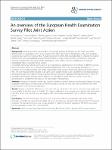An overview of the European Health Examination Survey Pilot Joint Action
Kuulasmaa, Kari
Tolonen, Hanna
Koponen, Päivikki
Kilpeläinen, Katri
Avdicová, Mária
Broda, Grazyna
Calleja, Neville
Dias, Carlos
Gösswald, Antje
Kubinova, Ruzena
Mindell, Jennifer
Männistö, Satu
Palmieri, Luigi
Tell, Grethe S.
Trichopoulou, Antonia
Verschuren, WM M.
Background: Health Examination Surveys (HESs) can provide essential information on the health and health determinants of a population, which is not available from other data sources. Nevertheless, only some European countries have systems of national HESs. A study conducted in 2006–2008 concluded that it is feasible to organize national HESs using standardized measurement procedures in nearly all EU countries. The feasibility study also outlined a structure for a European Health Examination Survey (EHES), which is a collaboration to organize standardized HESs in countries across Europe. To facilitate setting up national surveys and to gain experience in applying the EHES methods in different cultures, EHES Joint Action (2010–2011) planned and piloted standardized HESs in the working age population in 12 countries. This included countries with earlier national HESs and countries which were planning their first national HES. The core measurements included in all surveys were weight, height, waist circumference and blood pressure, and blood samples were taken to measure lipid profiles and glucose or glycated haemoglobin (HbA1c). These are modifiable determinants of major chronic diseases not identified in health interview surveys. There was a questionnaire to complement the data on the examination measurements. Methods: Evaluation of the pilot surveys was based on review of national manuals and evaluation reports of survey organizers; observations and discussions of survey procedures during site visits and training seminars; and other communication with the survey organizers. Results: Despite unavoidable differences in the ways HESs are organized in the various countries, high quality and comparability of the data seems achievable. The biggest challenge in each country was obtaining high participation rate. Most of the pilot countries are now ready to start their full-size national HES, and six of them have already started. Conclusions: The EHES Pilot Project has set up the structure for obtaining comparable high quality health indicators on health and important modifiable risk factors of major non-communicable diseases from the European countries. The European Union is now in a key position to make this structure sustainable. The EHES core survey can be expanded to cover other measurements.
Dateien zu dieser Publikation
Keine Lizenzangabe

